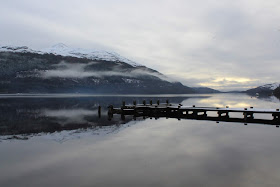 |
| The Amphitheatre from Thendele |
The Drakensberg is a spectacular escarpment that runs for
about 1000 kilometres along the eastern side of South Africa. The name was
coined by early Dutch settlers as Dragon
mountains, and from below it does look like an impressive mountains range
guarding the interior. Indeed, the Zulu people call it Khahlamba – barrier of up-pointed
spears. In fact, it isn’t a mountain range; it’s the dramatic drop from the
high country (Highveld) of South Africa down to the lower regions.
 |
| Cross section of southern Africa |
The creation of the escarpment dates back some 200 million
years to when the tectonic plates cracked and separated, splitting the super
continent of Gondwana into what would become the new continents of the world.
Huge eruptions created a massive basalt layer over the much older sedimentary
rocks and thrust the whole of southern Africa higher. Erosion moved the
escarpment back more than 100 kilometers from the original fault line.
During the past 20 million years there has been further
lifting of southern Africa, pushing the east higher with less elevation taking
place in the south and west. This led to the central-eastern high country with
elevations around 2,000 meters. The highest area is over 3,000 meters on the
eastern side along the border of what is now the Kingdom of Lesotho.
 |
| One of the Cascades |
The geological structure of the Drakensberg is unusual and
unusually beautiful. Huge cliffs face the east and crevices and caves are
common. These contain the rock art of the San people of the mountains, some
over 50,000 years old. The area was protected as
a national park in 1916 and declared a World Heritage Site in 2000.
The highest mountain, Thabane Ntlenyene, towers at 3500 metres. Two French missionaries reached it in 1836 and called it Mont Aux Sources, the mountain of sources, because the massive Orange River and Vaal Rivers rise here and make their way to the west, while the Tugela and other smaller rivers head down the escarpment to the east with impressive waterfalls along the way.
 |
| A visitor at the Cascades |
 |
| Guinea Fowls with seven shillings |
 |
| Olive Woodpecker - new bird for me |
Perhaps the most beautiful of all the wonderful scenic attractions
of the Drakensberg is the Amphitheatre, a huge concave ridge surrounding the
upper Tugela River. The river descends over a waterfall which is one of the
highest in the world.
 |
| Tugela Falls |
Afterwards, we climbed the escarpment again to the Highveld
before descending through passes to the Lowveld of Mpumalanga and the African
bush. I think the Royal Natal National Park may become a regular stop between
Knysna at the Cape coast and Olifants River game reserve in the bushveld.















































